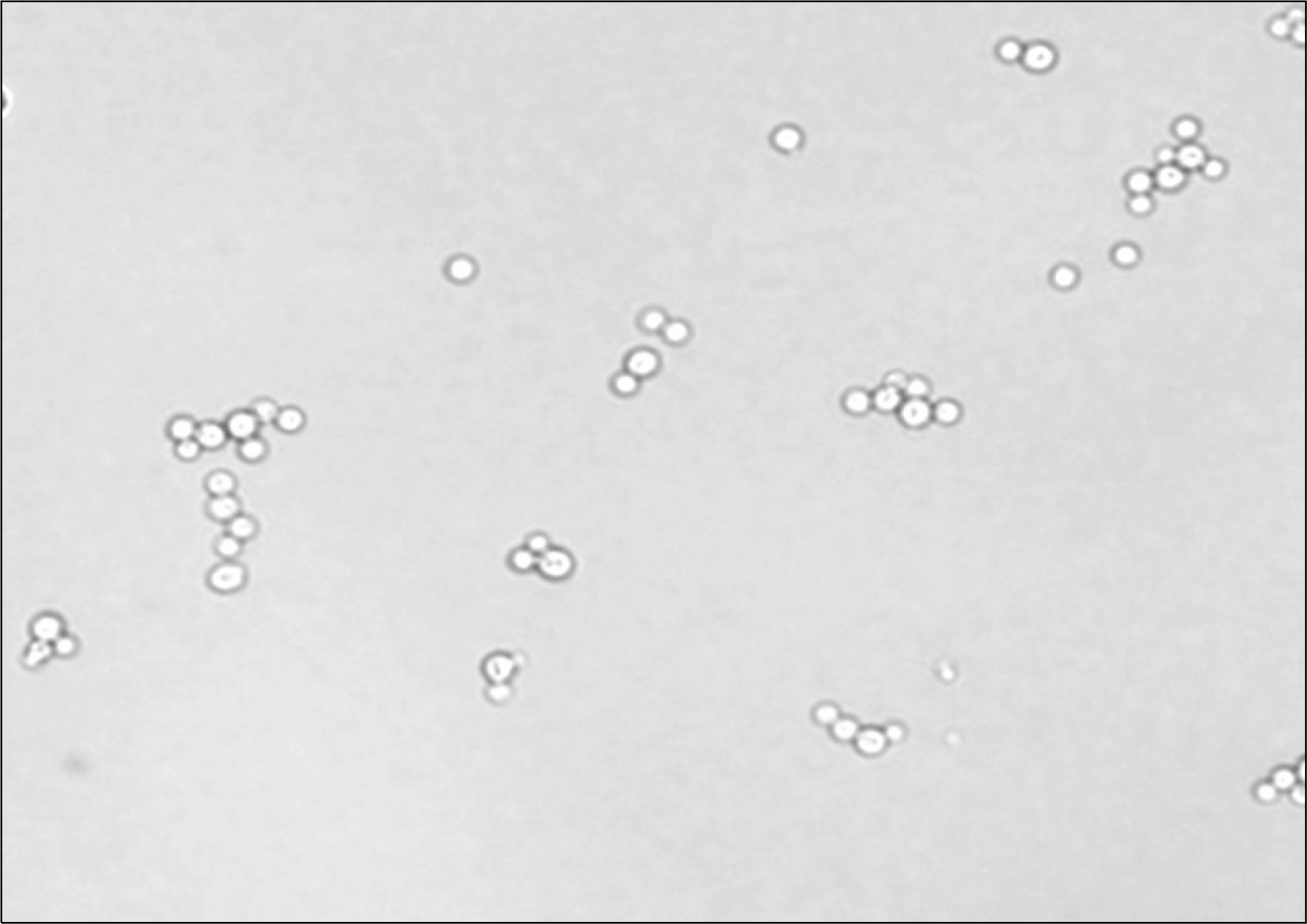Abstract
Cryptococcus is an opportunistic pathogen that mainly affects immunocompromised hosts and, less frequently, immunocompetent hosts. It causes serious morbidity and mortality due to systemic infections such as meningoencephalitis and pulmonary infection. Urinary involvement of Cryptococcus is sometimes reported among cases of disseminated cryptococcosis in AIDS patients, but no such reports have been published in Korea. We report two cases of cryptococcuria that developed in a 71-year old female with diabetes and liver cirrhosis and in a 50-year old male who received a liver transplant due to HBV-associated hepatic failure. The female patient had received prednisolone for 12 days before we detected C. neoformans in urine culture. Even though no antifungal therapy was indicated for cryptococcuria, following urine culture became negative, but still positive for cryptococcal antigen on hospital day 25. Her blood, CSF culture, and antigen tests were negative, and therefore she was diagnosed with isolated cryptococcuria. The male patient had received prednisolone and tacrolimus for 10 days before sputum and urine cultures became positive for C. neoformans. He had ill defined nodules and pleural effusion in both lungs on chest CT. His cryptococcuria was sustained for over 2 months, despite receiving amphotericin B treatment. His cryptococcuria seemed to be a symptom of disseminated cryptococcosis.
Go to : 
REFERENCES
1. Currie BP, Freundlich LF, Casadevall A. Restriction fragment length polymorphism analysis of Cryptococcus neoformans isolates from environmental (pigeon excreta) and clinical sources in New York City. J Clin Microbiol. 1994; 32:1188–92.

2. Idnurm A, Bahn YS, Nielsen K, Lin X, Fraser JA, Heitman J. Deciphering the model pathogenic fungus Cryptococcus neoformans. Nat Rev Microbiol. 2005; 3:753–64.

3. Lin X. Cryptococcus neoformans: morphogenesis, infection, and evolution. Infect Genet Evol. 2009; 9:401–16.

4. Mitchell TG and Perfect JR. Cryptococcosis in the era of AIDS–100 years after the discovery of Cryptococcus neoformans. Clin Microbiol Rev. 1995; 8:515–48.

5. Lee SJ, Choi HK, Son J, Kim KH, Lee SH. Cryptococcal meningitis in patients with or without human immunodeficiency virus: experience in a tertiary hospital. Yonsei Med J. 2011; 52:482–7.

6. Song KD, Lee KS, Chung MP, Kwon OJ, Kim TS, Yi CA, et al. Pulmonary cryptococcosis: imaging findings in 23 non-AIDS patients. Korean J Radiol. 2010; 11:407–16.

7. Kim SH, Kim SD, Kim HR, Yoon CH, Lee SH, Kim HY, et al. Intraabdominal cryptococcal lymphadenitis in a patient with systemic lupus erythematosus. J Korean Med Sci. 2005; 20:1059–61.

8. Song JC, Kim SK, Kim ES, Jung IS, Song YG, Yu JS, et al. A case of colonic cryptococcosis. Korean J Gastroenterol. 2008; 52:255–60.
9. Park WB, Choe YJ, Lee KD, Lee CS, Kim HB, Kim NJ, et al. Spontaneous cryptococcal peritonitis in patients with liver cirrhosis. Am J Med. 2006; 119:169–71.

10. Kang HY, Kim NS, Lee ES. Primary cutaneous cryptococcosis treated with fluconazole. Korean J Dermatol. 2000; 38:838–40.
11. Oh R, Song EH, Park KH, Cho OH, Kim T, Yun GJ, et al. A case of cryptococcal osteomyelitis with paraspinal abscess. Infect Chemother. 2008; 40:284–7.

12. Heo ST, Bae IG, Park JY, Kim SJ. Myositis due to Cryptococcus neoformans in a diabetic patient. Korean J Clin Microbiol. 2009; 12:141–3.
13. Kim IT, Kim JY, Kim HG. A case of cryptococcal chorioretinitis in a renal transplant patient. J Korean Ophthalmol Soc. 2002; 43:922–6.
14. Hong SI, Song MJ, Kim YS, Kim TH, Lee DG, Lee HK, et al. A case of cryptococcal meningitis developed after short-term therapy of steroid in a patient with autoimmune hemolytic anemia. Korean J Hematol. 2004; 39:191–5.
15. Martos JA, Vendrell J, Abos J, Ribera G. Diabetes mellitus as a predisposing factor in cryptococcal meningitis. An Med Interna. 1989; 6:276–7.
16. Mabee CL, Mabee SW, Kirkpatrick RB, Koletar SL. Cirrhosis: a risk factor for cryptococcal peritonitis. Am J Gastroenterol. 1995; 90:2042–5.
17. Chapin-Robertson K, Bechtel C, Waycott S, Kontnick C, Edberg SC. Cryptococcal antigen detection from the urine of AIDS patients. Diagn Microbiol Infect Dis. 1993; 17:197–201.

18. Kiertiburanakul S, Sungkanuparph S, Buabut B, Pracharktam R. Cryptococcuria as a manifestation of disseminated cryptococcosis and isolated urinary tract infection. Jpn J Infect Dis. 2004; 57:203–5.
19. Saha DC, Xess I, Biswas A, Bhowmik DM, Padma MV. Detection of Cryptococcus by conventional, serological and molecular methods. J Med Microbiol. 2009; 58:1098–105.

20. Chung S, Park CW, Chung HW, Chang YS. Acute renal failure presenting as a granulomatous interstitial nephritis due to cryptococcal infection. Kidney Int. 2009; 76:453–8.

Go to : 
 | Fig. 1.Chest X-ray and CT of two patients. Patient 1 showed slightly increased patchy ground glass opacity in right upper lobe on chest X-ray (A) and areas of patch ground glass opacity in right upper lobe and diffuse bronchial wall thickening in both lungs on CT suggesting focal pneumonia (B). Patient 2 showed no active lung lesion on chest X-ray (C), but patchy faint ground glass opacities and small amount of right pleural effusion on CT at HD 25 (D). |




 PDF
PDF ePub
ePub Citation
Citation Print
Print



 XML Download
XML Download